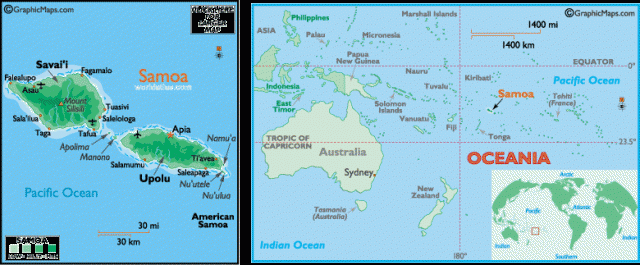Samoa
Area 1,137 square mi (2,944 square km)
Population 191,800 2014
Capital Apia
Highest Point Mauga Silisili 6,092 ft (1,857 m)
Lowest Point 0 m
GDP $800.4 million 2014
Primary Natural Resources hardwood forests, fish.
THE SAMOAN ARCHIPELAGO lies approximately midway between the Hawaiian islands and NEW ZEALAND and consists of scores of islands and atolls. Human migration into western POLYNESIA, including the Samoan archipelago, appears to date from 750 B.C.E., when scouts from the Fijian and Tongan islands arrived. Settlers soon arrived and, taking advantage of the islands' low costal plains protected by expansive reef structures, they cultivated an array of root crops.
The interior of the larger islands is characterized by rugged mountainous terrain, some of which are actively volcanic. The rocky interior is covered by large forests and dense jungle undergrowth, leaving it both inaccessible and inhospitable for farming. The tropical climate features high temperatures year-round, with a rainy season and occasional typhoons between October and March. The greatest natural hazards are infrequent but spectacular volcano eruptions, and progressive soil erosion accelerated by the recent expansion of the hardwood industry.

In the 1870s the Samoan archipelago became enmeshed in the Great Powers' plans to expand their spheres of influence in Oceania. European planters began to seize control of the western islands in the chain, intent on developing plantations for commercial production of coconuts and copra. In the eastern half of the archipelago, the American government wanted to create a coal depot to supply its naval and merchant fleets engaged in the trade with CHINA and JAPAN. Political rivalries between opposing clans were accentuated by foreign meddling.
In 1899, to avert the possibility of war, diplomats from Britain, GERMANY and the UNITED STATES convened to partition the islands, with Germany taking control of the western sector and the United States ruling the eastern islands. At the outset of World War I, Allied troops seized German Samoa. New Zealand received a mandate from the League of Nations to oversee the islands, and in 1962 the islands became independent as Western Samoa with the capital at Apia.
Western Samoa's economy remains heavily dependent upon agricultural exports and international development aid. In many cases, remittances from family members working abroad are crucial to household income. Samoan youth regularly leave the country in search of employment. New Zealand accepts 1,100 Samoan immigrants annually, but it is believed that hundreds more enter New Zealand illegally and merge into its underground economy. American Samoa, always the smaller of the two sectors, was largely left undisturbed by Washington, D.C., until the beginning of World War II, when it became a strategically valuable outpost for American forces battling Japanese expansionism in the Pacific. Airfields, roads, and other military facilities were hastily expanded.
After the war, U.S. policy permitted hundreds of locals to enter the U.S. Navy, and many of these later moved with their families to America's west coast. Although a constitution was promulgated in 1960, American Samoa remains an unincorporated territory without full electoral representation in the U.S. Congress.